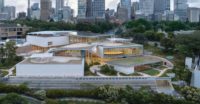Tel Aviv, Israel
The atrium, or Lightfall, inside the just-completed Amir Building addition to the Tel Aviv Museum of Art serves much the same purpose as the space at the heart of Frank Lloyd Wright’s Solomon R. Guggenheim Museum in New York City: Both are dramatic, sculptural voids with circulation spiraling around their perimeters. But the similarities end there, points out Preston Scott Cohen, the new building’s architect. Unlike the Guggenheim atrium, the Lightfall “doesn’t consume the whole museum,” says Cohen. It allows for the flexible, rectangular galleries that his client desired.
Although the shapes of the Tel Aviv Museum’s new exhibition spaces are much more conventional than that of the Lightfall they surround, the structure of the galleries is still complex, notes Dani Schacham, a partner with YSS, the project’s structural engineer. The galleries are composed of stacked structural systems, with each level rotated 22.5 degrees relative to the one below. Vierendeel trusses, some carrying two levels and almost 30 feet deep, span as much as 110 feet. These carry smaller intermediary members.
In addition to providing large, mostly column-free exhibition spaces, the strategy permitted designers to take advantage of the structure’s depth for ductwork and other equipment, without encroaching on the height of galleries. However, routing the mechanical systems around and through the steel members required intense coordination with the project’s 3-D model and among different trades, points out Amit Nemlich, project architect. “HVAC integration was a real challenge,” he says.
All involved in the project agree that the Lightfall proved an even tougher design and construction problem because it is made up of 28 poured-in-place concrete hyperbolic paraboloids, or doubly ruled surfaces curved like saddles and often referred to as “hypars.” Schacham describes the configuration of the Lightfall’s surfaces as a “rectangular spring”: Each hypar is supported by adjacent hypars, so that they form a self-supporting object that coils vertically 87 feet, bringing daylight from a skylight to the lowest gallery level, more than 42 feet below grade. The assemblage, which is structurally independent from the surrounding gallery framing, is designed to withstand gravity and seismic loads, but with concrete thicknesses of only 6 or 7 inches. However, in some locations, where two surfaces join, the concrete is as thick as 15 inches. The Lightfall walls would have been even thicker at its prowlike corners, but contractors devised steel cages for these areas that remain buried in the concrete and define interior voids. The hollows reduced the amount of concrete required, along with its associated loads, and made it possible for workers to fasten the formwork with tie rods.
The concrete surfaces are finished in white plaster on the Lightfall’s interior but left exposed on the gallery-facing side, revealing the imprint of the formwork constructed of curved 3-inch spruce strips in a process that Nemlich likens to shipbuilding. Contractors braced this hull-like inner formwork layer with bent plywood sheets and an outer structure of straight steel tubes welded together in a fanlike array to conform to the hypars’ curves.
Embedded inside each hypar is a dense network of reinforcing bars. Once a pour began, contractors hit the formwork with mallets and applied vibration to prevent air from becoming trapped and to ensure the concrete’s complete consolidation. They also carefully monitored the speed of the hydration process to avoid cracking—a particular concern in the few areas where the concrete is especially thick. Because of the demanding geometry and a desire for pristine surfaces, some of the hypars took as long as a month to construct, according to Israel Chaskelevitch, principal of construction management firm Chaskelevitch Engineering. “Even the concrete that would be covered with plaster needed to be precise,” he says.
People |
Products |










Post a comment to this article
Report Abusive Comment